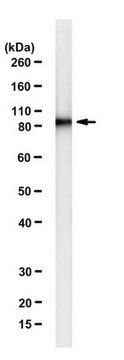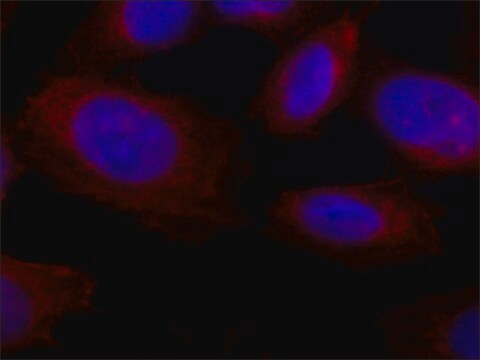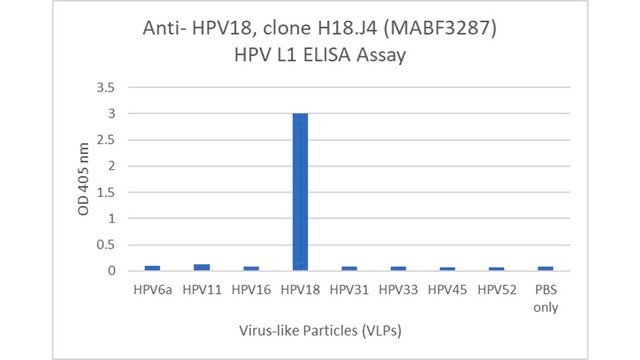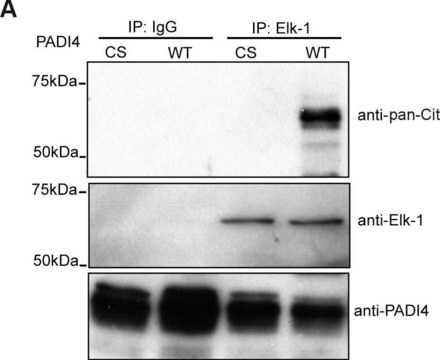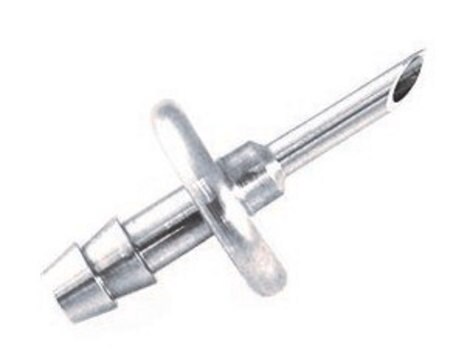MABF3220
Anti- HPV16 Antibody, clone H16.V5
Sinonimo/i:
HPV-16, Major capsid protein L1
About This Item
Prodotti consigliati
Origine biologica
mouse
Livello qualitativo
Forma dell’anticorpo
purified antibody
Tipo di anticorpo
primary antibodies
Clone
H16.V5, monoclonal
PM
calculated mol wt 56.3 kDa
observed mol wt ~N/A kDa
Purificato mediante
using protein G
Reattività contro le specie
virus
Confezionamento
antibody small pack of 100
tecniche
ELISA: suitable
neutralization: suitable
Isotipo
IgG2bκ
N° accesso ID proteina
N° accesso UniProt
Temperatura di conservazione
-10 to -25°C
Informazioni sul gene
vaccinia virus ... L1(1489082)
Specificità
Immunogeno
Applicazioni
Isotype testing: Identity Confirmation by Isotyping Test.
Isotyping Analysis: The identity of this monoclonal antibody is confirmed by isotyping test to be mouse IgG2b .
Tested Applications
ELISA Analysis: A representative lot of this antibody detected HPV16 protein in ELISA application (Data by Dr. J. Leitsch and with kind permission of ARTES Biotechnology GmbH, Germany. Recombinant HPV L1 antigens used were produced by ARTES Biotechnology GmbH).
Neutralizing: A representative lot detected HPV16 in Neutralizing application (Christensen, N.D., et al. (1996). Virology. 223(1):174-84; McClements, W.L., et al. (Virology). 289(2):262-8; Dias, D., et al. (2005). Clin Diagn Lab Immunol. 12(8):959-69; Smith, J.F., et al. (2008). Hum Vaccin. 4(2):134-42; Jerajani, K., et al. (2022). J Pharm Sci. 111(11):2983-2997).
ELISA Analysis: A representative lot detected HPV16 in ELISA application (Christensen, N.D., et al. (1996). Virology. 223(1):174-84; McClements, W.L., et al. (Virology). 289(2):262-8; Smith, J.F., et al. (2008). Hum Vaccin. 4(2):134-42; Panicker, G., et al. (2021). J Immunol Methods. 498:113136; Jerajani, K., et al. (2022). J Pharm Sci. 111(11):2983-2997).
Note: Actual optimal working dilutions must be determined by end user as specimens, and experimental conditions may vary with the end user.
Descrizione del bersaglio
Stato fisico
Ricostituzione
Stoccaggio e stabilità
Altre note
Esclusione di responsabilità
Non trovi il prodotto giusto?
Prova il nostro Motore di ricerca dei prodotti.
Codice della classe di stoccaggio
12 - Non Combustible Liquids
Classe di pericolosità dell'acqua (WGK)
WGK 2
Punto d’infiammabilità (°F)
Not applicable
Punto d’infiammabilità (°C)
Not applicable
Certificati d'analisi (COA)
Cerca il Certificati d'analisi (COA) digitando il numero di lotto/batch corrispondente. I numeri di lotto o di batch sono stampati sull'etichetta dei prodotti dopo la parola ‘Lotto’ o ‘Batch’.
Possiedi già questo prodotto?
I documenti relativi ai prodotti acquistati recentemente sono disponibili nell’Archivio dei documenti.
Il team dei nostri ricercatori vanta grande esperienza in tutte le aree della ricerca quali Life Science, scienza dei materiali, sintesi chimica, cromatografia, discipline analitiche, ecc..
Contatta l'Assistenza Tecnica.



